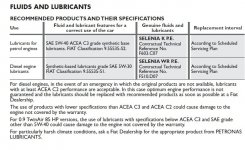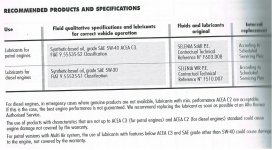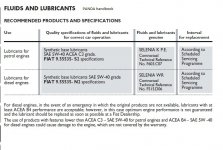And engine wear - the C2 spec allows for about 30% more wear for a 1.5% improvement in fuel economy. As you say, SAPS limits are the same for C2/C3. More details
here.
My previous comments were about oil generally, rather than the specific differences between C2/C3

.
Lets not forget 1 very important point, No one is going to recommend using the asda oil because no one other than asda is able to sell it. The important think is that it meets or betters the spec needed which it dose and is the correct grade. For me thats good enough. :slayer:
I've no idea why I'm still re-visiting this thread but it was would be an interesting exercise to see what will be the effects
if any on using an up-to-date ASDA ACEA C3 in a Multi-jet engine.
From a phonecall with a Supplier and a direct supplier of an oil for a petrol engine that gave 5% improvement in power (Click
here) I was advised against using it since it was too new and no one knows what the long term impacts would be.
Re-looking at the C2 spec having 30% more wear than the C3 this was addressed in the 2010 C2-10 spec where the C2 was made 'as good as' the C3 on 'wear protection'. Up to this - Suppliers had stated that the C3 was better than C2.
http://www.lubrizol.com/EngineOilAdditives/ACEA/Sequences/ACEA-C2-10.html
The inclusion of the new OM646LA engine test raises the diesel wear protection performance demanded from ACEA C2 oils.
On the attached comparison 'makeup' of the ACEA C2 & C3, the C2 economy benefits are obvious with a marginal benefit in the 'soot thickening' category for the C3. In lowering the emissions it gives more economy and it will become a trend (Click
here). Also it may require more regular oil changes to stop
this happening.
http://www.sciencedirect.com/science/article/pii/S0301679X1100315X
Another key difference between a ACEA C3 and ACEA C2 aside from economy is that using a C3 will increase emissions - this could end up been a key factor if you are a borderline case on an a MOT test. At that stage being arsed to change to correct oil might be too late.
Here is a report (Click
here - it's a 5meg) of various oils and their performance on a scar test. Quite a few surprises in that a branded oil like Mobil 1 whilst performing well in the economy and power categories didn't do the engine any favours in the 'wear' department. Another lesser know oil did really well given it's price (Valvoline). Oil in the particular spec for the MJ (
Valvoline Synpower ENV C2 SAE 5W30) can be got (Click
here). Also I would rely on an expert opinion from a reputable supplier & I would suspect that Fuchs, Millers & Motul would come into the short list. It goes to show you that paying top $ for an oil does not guarantee that it's good for your engine. There is also another 'school of thought' that economy oils are not doing your engine any favours (click
here). Some experts are recommending to increase viscosity (click
here) stating that its ok e.g. to use a 5w40 in place of a 5w30 if it's warranted for cars outside the warranty period.
The issue with having a DPF on the Fiat and it requiring a 'Low ash oil' means that the best performing Esther oil cannot be used. The only one in this category that has some Esther content is the Mobile One ESP 5w30 but I would only consider it on a car requiring ACEA C3. Some of the newer performing diesel engines from 'Fiat' do not need a C2 so that a 'performance' oil can be used.
The last point about the Fiat Approval spec
FIAT 9.55535-S1 - although 'nice to have' it's not 'enforceable'. Once you meet the viscosity and ACEA spec I cann't see how a warranty claim could be refused on these grounds.
There are specialist sites out there on oil but to keep it 'simple' I've taken an extract from the AA website where it is clearly states that for a Diesel engine C2 is the best ACEA.
http://www.theaa.com/motoring_advic.../engine-oils-viscosity-and-specification.html
If you have a diesel car fitted with a DPF you must use one of the latest 'low SAPS' (Sulphated Ash, Phosphorous, Sulphur) oils. Using 'normal' oil instead of low SAPS can result in blocking of the DPF.
C1 Low SAPS (0.5% ash) fuel efficient
C2 Mid SAPS (0.8% ash) fuel efficient, performance
C3 Mid SAPS (0.8% ash)




